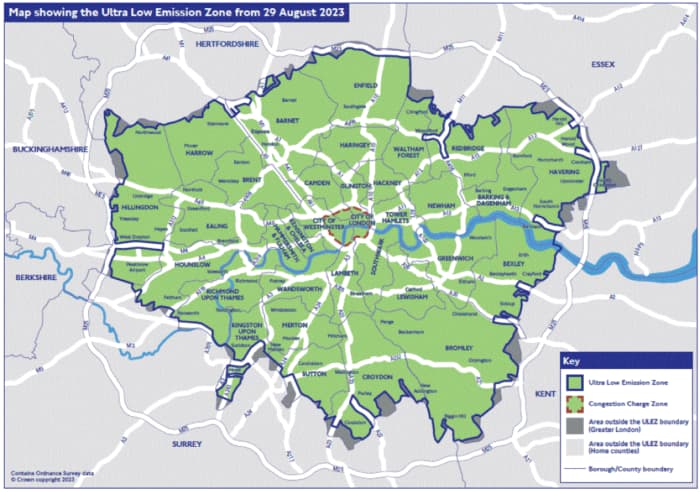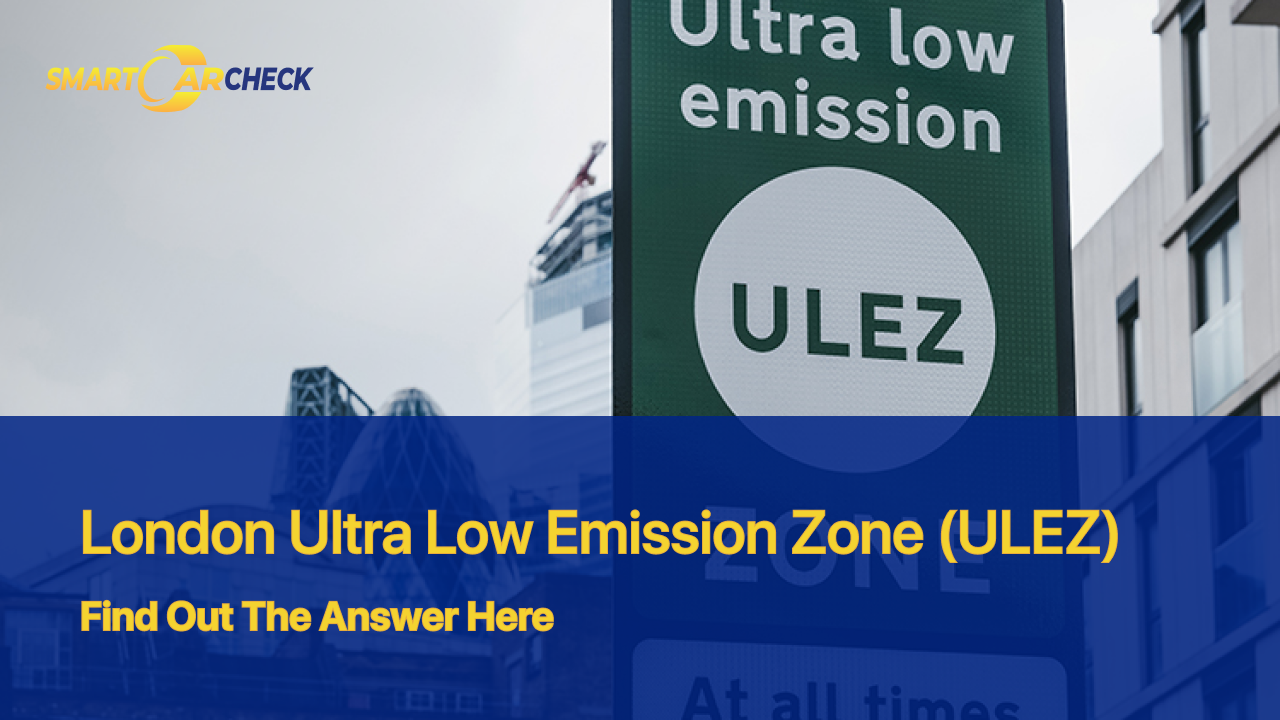In an effort to improve air quality and public health, London implemented the Ultra Low Emission Zone (ULEZ) in April 2019. The ULEZ is a central zone within London that restricts certain vehicles from entering unless they meet strict emission standards. What do you know about the London Ultra Low Emission Zone? Learn all you need to know in this article!
What is the London Ultra Low Emission Zone?
The ULEZ was introduced with a main aim of improving London’s air quality and public health, while trying to curb climate change. So far, it is now the largest clean air zone in the world and has cut down pollution in these areas by up to 95%. Remarkable right? What exactly is the ULEZ?
The London Ultra Low Emission Zone (ULEZ) is a zone in central London that restricts older, more polluting vehicles from entering. This way, air quality in London is improved by reducing nitrogen oxide (NOx) and particulate matter (PM) emissions from vehicles.
Does this mean vehicles failing to meet the criteria are not allowed to go through? Well, not exactly. They can drive through but then they would have to pay the ULEZ daily charge.
History of the ULEZ
How did it all start? Here’s a brief history.
2019 Central Zone
Originally, the whole idea of an ultra-low emission zone was first considered in 2014 under Boris Johnson, Mayor of London. However, it was not until 2015 that the plans for the ULEZ were announced. It was supposed to cover the same areas as the existing Central London congestion charge.
On April 8th, 2019, it was finally introduced by Sadiq Khan, Johnson’s successor. The initial zone covered Central London and aimed to reduce emissions from non-compliant vehicles.
2021 Inner Expansion
On October 25, 2021, the ULEZ was expanded 18 times the size of the Congestion Zone to include the Inner London area within the North Circular and South Circular roads.
With this expansion, approximately 3.8 million people were covered giving them cleaner air and 44% less emissions and non-compliant vehicle had to pay a charge to enter the zone.
At this point, Transport for London (TfL) found that around 87% of vehicles driven in the ULEZ zone were already compliant with the emissions rules. With around a million vehicles driving within the expanded zone, nearly 140,000 vehicles had to be replaced or pay the daily charge, including 100,000 cars, 35,000 vans, and 3,000 heavy goods vehicles.
But it doesn’t end here!
2023 Outer Expansion
On 29 August, 2023, again the ULEZ continued to evolve. This time, it was extended to cover all of Greater London. This ULEZ expansion covered over 1,500 square kilometers (580 sq mi) and approximately 9 million people.
In summary, the ULEZ has been a crucial initiative to combat air pollution and create a healthier urban environment in London. Sometimes, some school of thought tend to debate its effectiveness and value, but its impact on emissions and air quality remains undeniable
How much does the ULEZ cost?
Now, what happens to vehicles not compliant with the ULEZ criteria? They have to pay a daily charge to drive. Yes! As of 2024, the ULEZ charge for non-compliant vehicles driving within the zone is £12.50 for most vehicle types (up to and including 3.5 tonnes), including cars, motorcycles, vans, mini-buses, and HGVs (Heavy Goods Vehicles).
The ULEZ operates 24 hours a day, 7 days a week, every day of the year, including weekends and holidays except Christmas day (25th December). It’s essential to note that the ULEZ charge is in addition to any congestion charges that may apply.
What this means is, if you’re going to be within the ULEZ zone for 2 days with a non-compliant vehicle, you will need to pay a £12.50 daily charge and that’s £25 for 2 days.
However, lorries, vans, and specialist heavy vehicles (over 3.5 tonnes) and buses, minibuses, and coaches (over 5 tonnes) do not need to pay the ULEZ charge. They are subject to the Low Emission Zone (LEZ) charge if they don’t meet LEZ emissions standards.
Criteria for vehicles entering ULEZ: London ULEZ Rules
London ULEZ rules for cars
The minimum emission standards for cars entering this zone are Euro 4 (NOx) and Euro 6 (NOx and PM) for Petrol and Diesel cars respectively. Petrol cars that meet the standards are cars registered with the DVLA as new after 2005. For Diesel vehicles, they must have registered as new after September 2015.
London ULEZ rules for vans, minibuses and more
For small vans, larger vans, 4×4 utility vehicles, ambulances, motorcaravans, motorized hearses, minibuses, and more, the minimum standards are Euro 4 emission standards (NOx) and Euro 6 emission standards (NOx and PM) for petrol and diesel vehicles.
Diesel vans registered as new from September 2016 and Petrol vans registered from January 2006 meet these standards. Also note that vans, lorries and HGVs weighing more than 3.5 tonnes do not need to pay the ULEZ charge. This also applies to buses, minibuses, and coaches over 5 tonnes. They are not affected by the ULEZ charge.
Read Also: Riding a Motorbike with a Full Car Licence: Everything You Should Know
London ULEZ rules for motorcycles, mopeds, and more
Motorcycles, mopeds, motorized tricycles, and quadricycles need to meet the Euro 3 emissions standards for NOx. In general, if they are registered after July 2007, they can be considered Euro 3 engines and are compliant.
Geographic coverage of ULEZ in London

The ULEZ zone covers most of central London, including the City of London and Westminster. The zone is bounded by the inner ring road (A406 North Circular) to the north, the A40 West Cross Route to the west, the A2 South Circular to the south, and the M4 motorway to the east.
Impact of ULEZ on Air Quality
Since its introduction in 2019, the ULEZ has had a significant impact on air quality in London. Here are some facts about the impact:
- A study by Imperial College London found that the ULEZ has led to a 95% reduction in nitrogen dioxide (NO2) levels within the zone.
- There was an 800,000 tonne reduction in carbon dioxide emissions between 2019 and 2022.
- The ULEZ has led to a reduction in respiratory admissions to hospitals in London.
- Pollution levels in inner London are 21% lower than they would have been without the ULEZ.
- Each day, 74,000 fewer polluting vehicles are seen driving in the ULEZ, resulting in a 60% reduction since the expansion in October 2021.
- Over four million people now breathe cleaner air in inner London, including children in 1,362 schools.
How to check if a vehicle is ULEZ compliant
Checking if a vehicle meets the ULEZ standards is straightforward and easy with Smart Car Check’s tool. To verify if you need to pay the charge, all you need is your vehicle registration number.
Simply enter the reg number and email address into the form on this page to get a ULEZ check.
Paying the ULEZ Charge with TFL
If your vehicle doesn’t meet the ULEZ emissions standards and isn’t exempt, you will need to pay the charge. There are several easy methods to pay the ULEZ charge of £12.50. But first, you need to be sure your vehicle doesn’t meet the criteria. You can verify with our reg check tool.
Need to pay? You can:
- Visit the Tfl Website: Here, you can register for AutoPay to pay the charge automatically each time you visit the ULEZ zone. Note that there’s an annual £10 admin fee per vehicle but you could get a discount for more than five vehicles.
- Pay with the Pay to drive in London mobile app.
- Pay by phone: 0343 222 2222 (TfL call charges may apply), +44 343 222 2222 (International), 020 7649 9123 for textphone (if you have impaired hearing) and these lines are open from Monday to Friday, 08:00 -20:00.
- Pay through a London Road User Charging account.
Remember that failure to pay within 3 days from your visit leads to a Penalty Charge Notice (PCN) of £180, or £90 if paid within 14 days.
Exemptions and Discounts
Think your vehicle may be exempt from the ULEZ charge? Here is a list of drivers and vehicles that qualify for at least a temporary 100% discount from the London low emission zone charge.
- Vehicles for disabled people – Disabled vehicles registered with the DVLA as having disabled passengers are exempt from paying the ULEZ charge until 24 October 2027, as long as they remain under the same tax class until then.
- NHS patient reimbursement – If you are clinically assessed as too ill to travel on public transport, you can claim back any ULEZ charge paid to travel to an appointment. You can ask your hospital to find out your eligibility.
- Taxis – London-licensed taxis are exempt from ULEZ charges. Older ones have a 12 year age limit and cleaner taxis can be exempt for up to 15 years.
- Business and charity short-term grace period – This exemption applies to small businesses and microbusinesses. They can apply for exemption for a grace period before 29 May 2024 but they need to have a new vehicle or retrofit ordered before 29 November 2023.
- Minibuses for community transport – Not-for-profit organizations using minibuses can register for a temporary 100% discount of the charge until 26 October 2025.
- Wheelchair accessible private hire vehicles (PHVs) – PHVs used to carry out private bookings will receive a grace period of exemption until 24 October 2027.
- Historic vehicles – All vehicles built before 1st January 1973 and vehicles over 40 years registered with the DVLA are exempt from the ULEZ charge.
Some other vehicles that don’t pay the ULEZ charge are:
- Military vehicles
- Specialist agricultural vehicles
- Non-road going vehicles
- Certain types of mobile cranes.
- Showman’s vehicles
You can apply for an exemption or discount online through the TfL website. To qualify for a discount, your vehicle must meet certain emissions standards. Find out about those standards with the Tfl.
For those with vehicles who need to pay the daily charge to drive within, there’s the London ULEZ scrappage scheme! Let’s look at this in the next section.
London ULEZ Scrappage Scheme
The London ULEZ scrappage scheme introduced on the 29th of August 2023 offers financial support to London residents who scrap, donate, or retrofit (in some cases) polluting vehicles that can’t enter the ULEZ zone without incurring a daily charge.
This £160 million assistance program aims to:
- Reduce air pollution and improve public health in London.
- Encourage the switch to cleaner vehicles, like electric or hybrid models.
So how does it work and how much is provided:
The amount you receive depends on the type of vehicle you scrap or donate:
- Cars and motorbikes: Up to £2,000 for scrapping a car or up to £1,000 for scrapping a motorcycle, with additional options that include public transport passes.
- Wheelchair-accessible vehicles: Up to £10,000 for scrapping or donating, or £6,000 for retrofitting to ULEZ standards (subject to approval).
The scrappage scheme is open to:
All London residents with non-compliant cars, motorbikes, or wheelchair-accessible vehicles.
Small businesses (under 50 employees), sole traders, and charities can scrap up to three vans (increased from one in 2023).
Overall, London’s Ultra Low Emission Zone (ULEZ) operating across all London boroughs plays a crucial role in the city’s efforts to combat air pollution and create a healthier environment for its residents. If you have a non-compliant car, you can take advantage of the scrappage scheme and get a compliant vehicle. Don’t forget to check if your vehicle is compliant or not with our reg check tool.


